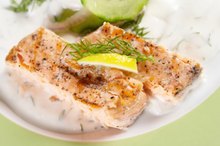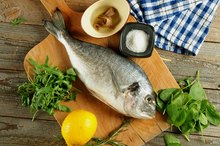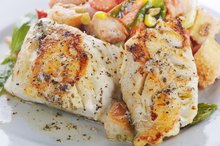Flounder & Sole Nutritional Data
Sole and flounder are both flatfish found at the bottom of the ocean. While they are two different types of fish, both sole and flounder taste the same and have the same nutritional make up. In either case, you can't go wrong by including one of these fish in your diet. In fact, the 2010 dietary guidelines for Americans recommends you eat 8 ounces of fish a week to lower your risk of heart disease. Knowing the nutritional data for flounder and sole can help you see their nutritional benefits.
Low-Energy Dense Fish
A 3.5 ounce, or 100 gram, cooked portion of either sole or flounder has 117 calories. With just 1.2 calories per gram, sole and flounder are low-energy dense foods, which means they have few calories compared to their weight. Including more low-energy dense foods in your diet helps you feel full on fewer calories, which might make it easier for you to manage your weight.
Good Source of Protein
The Best Fish for Diabetics
Learn More
Sole and flounder are both good sources of protein, with 24 grams in a 3.5-ounce cooked portion. Women need 46 grams of protein a day, and men need 56 grams, so one serving of the fish meets almost half of your recommended daily protein needs. Additionally, sole and flounder contain all of the essential amino acids, making it a high-quality source of protein. Every cell in your body contains protein, which makes it essential for maintaining and repairing tissue, organs and muscles.
Low In Fat
Sole and flounder are very low in fat, with 1.5 grams of total fat per 3.5-ounce serving. While fat in food is a good source of calories, and helps you absorb fat-soluble vitamins, getting too much fat in your diet increases your risk of heart disease. In addition to being a very low-fat protein food, sole and flounder are also very low in saturated fat, with 0.4 grams per 3.5-ounce serving. Saturated fat in food raises blood-cholesterol levels, and the U.S. Department of Agriculture recommends that less than 10 percent of your calories should come from saturated fat.
Rich in Vitamins and Minerals
Nutrition of Mahi Mahi Vs. White Fish
Learn More
Sole and flounder are good sources of B vitamins, magnesium and phosphorus. You need B vitamins to help turn the food you eat into energy. B vitamins are also necessary for the production of red blood cells. Magnesium is a mineral that also helps in energy production, and is also needed to make protein and aid in blood sugar and blood pressure control. Phosphorus is important for healthy teeth and bones.
Related Articles
References
- FatFree: Fish/Shellfish; Flatfish (Flounder and Sole Species), Cooked, Dry Heat
- U.S. Department of Agriculture: 2010 Dietary Guidelines for Americans
- Centers for Disease Control and Prevention: Low-Energy Dense Foods and Weight Management: Cutting Calories While Controlling Hunger
- MedlinePlus: B Vitamins
- Office of Dietary Supplements: Magnesium
- MedlinePlus: Phosphorus in Diet
Writer Bio
Jill Corleone is a registered dietitian and health coach who has been writing and lecturing on diet and health for more than 15 years. Her work has been featured on the Huffington Post, Diabetes Self-Management and in the book "Noninvasive Mechanical Ventilation," edited by John R. Bach, M.D. Corleone holds a Bachelor of Science in nutrition.









